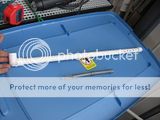bitteraspects
Fish Herder
- Joined
- Jan 11, 2009
- Messages
- 1,102
- Reaction score
- 0
(did this DIY write up for a member on another forum, but if someone else can make use of it, more power to you)
this is my first attempt at a smaller hob, so bare with me. i have done ac110 and canisters in the past, but this is a bit smaller. same concept though.
the HOB filter is a great idea. and works great for most aquarium systems, however there is a major flaw in the design. with the intake tube directly under the silde (waterfall portion of the filter), youre recycling a lot of clean water that just came out of the filter. im not sure about the exact math, but id be willing to say its AT LEAST 50%.
by moving the intake to the opposite side of the tank, you create a larger cycle area in your tank, and maximize efficiency of your filter.
lets go.
what youll need:




- aquaclear 50 HOB filter. (if im not mistaken, the AC30 also uses a 1/2" intake.
-1/2" pvc ($2 for a 10' pipe at home depot)
-2 hose clamps (though i only ended up using one. more on that later)
- 1 1/2" end cap for the pvc ( $.20)
- 1 1/2" 90 degree elbow ($.30)
- 5/8" tubing. you can usually find this for sale at your LFS. and if i remember correctly, they sell it by the inch. you will only need about 2" for this application.
- silicon (i dont use it, but you can if you want to make sure everything is tight.)
- a chop saw or hack saw with a fine toothed blade. (the finer the tooth pattern, the less likely you will have any problems cutting the PVC)
- a drill (with drillbit)
- a pot for boiling water ("what the hell is he talking about?!?!?!?")
first the measurement. i did this DIY for a 20L, so if youre using a different size tank, you will need to adjust it to fit.
this isnt an exact science, so, while you could get out the tape mesure and actually measure everything out, i found that eyeballing it was just fine.
you will need 2 pieces of PVC. one that runs the length of the tank, and one thats about 2" shy of the height. again, not an exact science, so you will have to adjust a little to fit your needs.
after you cut the 2 pieced of PVC to length. you will want to put on a pot of water and get it to a boil.

more on this in a minute...
while your water is coming to a boil. get your drill, and put a few holes in the far end of the longer piece of PVC. (the side away from the intake)

after you holes are drilled. clean out any debris from the inside and around the holes. id suggest giving it a good rinse to be sure. then place your endcap on the drilled side, and 90 degree elbow on the other. make sure you assemble it so that the holes face forward, and the elbow is facing up.



is your water boiling yet?
take the intake "U" tube off the filter. you will also need your hose clamps and the shorter piece of pvc.

with a pair of tongs (i use my fingers, but you might not want to get that close to the boiling water) stick the piece of tubing in the boiling water. just a few seconds should be long enough to soften it up.
when the tube is soft, slip it onto the end of the "u" tube and the end of the pvc. and clamp with hose clamps.

(the hose i used was thick, so the second clamp didnt fit. but also, the squeeze was so tight to get it on, it wasnt necessary)
and thats about it. assemble the pieces of PVC and reattach the "u" tube to the HOB.
this is where you would want to use the silicone if you want. i find its overkill though. and if you do use the silicone, you will need to let it cure for 2 days before filling the aquarium.
since i didnt, it was fill and go for me. lol




happy with their new filter



thats all folks. all thats left to do is rock out!

this is my first attempt at a smaller hob, so bare with me. i have done ac110 and canisters in the past, but this is a bit smaller. same concept though.
the HOB filter is a great idea. and works great for most aquarium systems, however there is a major flaw in the design. with the intake tube directly under the silde (waterfall portion of the filter), youre recycling a lot of clean water that just came out of the filter. im not sure about the exact math, but id be willing to say its AT LEAST 50%.
by moving the intake to the opposite side of the tank, you create a larger cycle area in your tank, and maximize efficiency of your filter.
lets go.
what youll need:




- aquaclear 50 HOB filter. (if im not mistaken, the AC30 also uses a 1/2" intake.
-1/2" pvc ($2 for a 10' pipe at home depot)
-2 hose clamps (though i only ended up using one. more on that later)
- 1 1/2" end cap for the pvc ( $.20)
- 1 1/2" 90 degree elbow ($.30)
- 5/8" tubing. you can usually find this for sale at your LFS. and if i remember correctly, they sell it by the inch. you will only need about 2" for this application.
- silicon (i dont use it, but you can if you want to make sure everything is tight.)
- a chop saw or hack saw with a fine toothed blade. (the finer the tooth pattern, the less likely you will have any problems cutting the PVC)
- a drill (with drillbit)
- a pot for boiling water ("what the hell is he talking about?!?!?!?")
first the measurement. i did this DIY for a 20L, so if youre using a different size tank, you will need to adjust it to fit.
this isnt an exact science, so, while you could get out the tape mesure and actually measure everything out, i found that eyeballing it was just fine.
you will need 2 pieces of PVC. one that runs the length of the tank, and one thats about 2" shy of the height. again, not an exact science, so you will have to adjust a little to fit your needs.
after you cut the 2 pieced of PVC to length. you will want to put on a pot of water and get it to a boil.

more on this in a minute...
while your water is coming to a boil. get your drill, and put a few holes in the far end of the longer piece of PVC. (the side away from the intake)

after you holes are drilled. clean out any debris from the inside and around the holes. id suggest giving it a good rinse to be sure. then place your endcap on the drilled side, and 90 degree elbow on the other. make sure you assemble it so that the holes face forward, and the elbow is facing up.



is your water boiling yet?
take the intake "U" tube off the filter. you will also need your hose clamps and the shorter piece of pvc.

with a pair of tongs (i use my fingers, but you might not want to get that close to the boiling water) stick the piece of tubing in the boiling water. just a few seconds should be long enough to soften it up.
when the tube is soft, slip it onto the end of the "u" tube and the end of the pvc. and clamp with hose clamps.

(the hose i used was thick, so the second clamp didnt fit. but also, the squeeze was so tight to get it on, it wasnt necessary)
and thats about it. assemble the pieces of PVC and reattach the "u" tube to the HOB.
this is where you would want to use the silicone if you want. i find its overkill though. and if you do use the silicone, you will need to let it cure for 2 days before filling the aquarium.
since i didnt, it was fill and go for me. lol




happy with their new filter



thats all folks. all thats left to do is rock out!



 Not bad at all
Not bad at all /www.fishforums.net/index.php?showto...p;#entry2378525
/www.fishforums.net/index.php?showto...p;#entry2378525
